All photographs ©2008 Akshay Mahajan/Oxfam.
All rights reserved. This image may not be reproduced without expressed written permission from Oxfam.
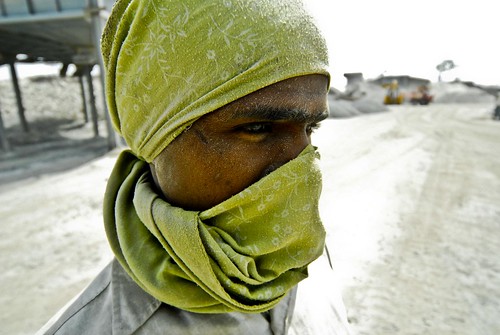
The boulders here are hard enough that the scavengers who have taken over the abandoned quarry south of downtown prefer not to strike them directly with their hammers.They heat the rocks first — with flaming tires, scrap plastic, even old rubber boots — so that the stones will fracture more easily. At dusk, when three or four blazes spew choking black clouds across the huge pit, the quarry looks like a woodcut out of Dante.
At the mouth of this stone quarry in Pune Maharashtra, diminutive women in saris toil 14 hour shifts breaking boulders into cricket-ball sized chunks of stone. Sledgehammers cut through to the air to the sound of splintering stone. Just behind them roared large machines that chewed up stone only to spit out construction gravel. Almost everybodies face was smeared with a white dust. A dust, heavy and suffocating, floating in the air like mist covering everything.
At the nearby settlement of Swegnagar, Laxmibai tells me about her work, "After washing, I make the fifteen minute walk to the quarry where I work, under a plastic tarp mounted on scavenged tree branches."
She adds, "I worked in this place for as long as I can remember. There is not a day in my life that has not involved breaking stone. I broke stone when I was a child, I broke stone when I was pregnant, I broke stone the day I gave birth."
Push and pull factors, bring people from all over Maharashtra and neighboring states to work at these stone quarries. Without local documents like ration cards and voters cards these men and women are invisible. As far as the Indian government is concerned some of them do not even exist.
1.
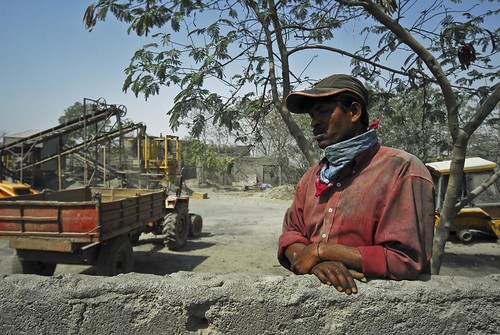
2.
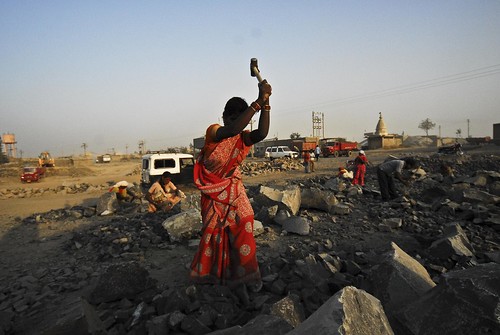
3.
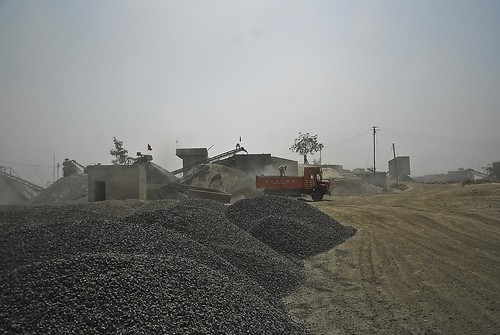
4.
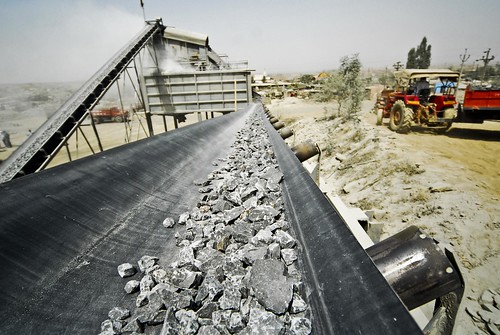
5.

[Suresh works in this purgatory six days a week.Nine years old, nearly lost in a hooded sweatshirt with a skateboarder on the chest, he takes football-size chunks of fractured rock and beats them into powder]
6.
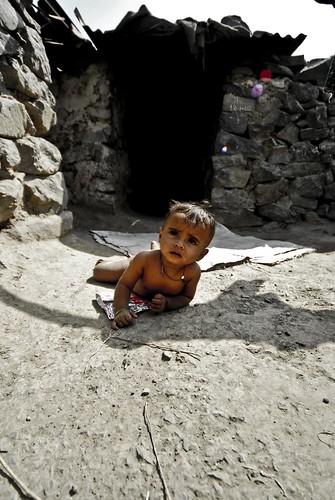
7.

[ After many years of breaking silica stone, crushing it, breathing it in as dust and coughing it out as disease, Raja Vitkar has been left too ill even to walk upright, and too breathless to tell his story.
A large number of quarry workers die a slow death without any compensation from their employers, having no proof to link their illness to the conditions of work.
Silicosis, one of the oldest occupational diseases, still kills thousands of people every year, everywhere in the world. It is an incurable lung disease caused by inhalation of dust containing free crystalline silica. It is irreversible and, moreover, the disease progresses even when exposure stops. Extremely high exposures are associated with much shorter latency and more rapid disease progression.]
More pictures from this series HERE
All rights reserved. This image may not be reproduced without expressed written permission from Oxfam.

The boulders here are hard enough that the scavengers who have taken over the abandoned quarry south of downtown prefer not to strike them directly with their hammers.They heat the rocks first — with flaming tires, scrap plastic, even old rubber boots — so that the stones will fracture more easily. At dusk, when three or four blazes spew choking black clouds across the huge pit, the quarry looks like a woodcut out of Dante.
At the mouth of this stone quarry in Pune Maharashtra, diminutive women in saris toil 14 hour shifts breaking boulders into cricket-ball sized chunks of stone. Sledgehammers cut through to the air to the sound of splintering stone. Just behind them roared large machines that chewed up stone only to spit out construction gravel. Almost everybodies face was smeared with a white dust. A dust, heavy and suffocating, floating in the air like mist covering everything.
At the nearby settlement of Swegnagar, Laxmibai tells me about her work, "After washing, I make the fifteen minute walk to the quarry where I work, under a plastic tarp mounted on scavenged tree branches."
She adds, "I worked in this place for as long as I can remember. There is not a day in my life that has not involved breaking stone. I broke stone when I was a child, I broke stone when I was pregnant, I broke stone the day I gave birth."
Push and pull factors, bring people from all over Maharashtra and neighboring states to work at these stone quarries. Without local documents like ration cards and voters cards these men and women are invisible. As far as the Indian government is concerned some of them do not even exist.
1.

2.

3.

4.

5.

[Suresh works in this purgatory six days a week.Nine years old, nearly lost in a hooded sweatshirt with a skateboarder on the chest, he takes football-size chunks of fractured rock and beats them into powder]
6.

7.

[ After many years of breaking silica stone, crushing it, breathing it in as dust and coughing it out as disease, Raja Vitkar has been left too ill even to walk upright, and too breathless to tell his story.
A large number of quarry workers die a slow death without any compensation from their employers, having no proof to link their illness to the conditions of work.
Silicosis, one of the oldest occupational diseases, still kills thousands of people every year, everywhere in the world. It is an incurable lung disease caused by inhalation of dust containing free crystalline silica. It is irreversible and, moreover, the disease progresses even when exposure stops. Extremely high exposures are associated with much shorter latency and more rapid disease progression.]
More pictures from this series HERE